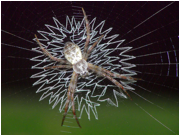Caught In a Sticky Situation:The Orb-Weaving Spiderweb
Emily Gastelum and Taylor Stinchcomb
Biology 342 Fall 2011
What is Adaptive Value?
As animal behavior has progressed as a science, Tinbergen's survival value has been reconsidered adaptive value to encompass the theory of natural selection. Questions of adaptive value examine how behavior contributes to an animal’s lifetime reproductive fitness: the probability of the organism’s reproduction and offspring survival. It is important to note that adaptive value refers to the present state of a behavior’s adaption, the evolutionary process that has led to it and also its possible future effects on the species’ survival.
The Value of Decoration
There is a high variance in web decorations occurring across species and also within species at both the population and individual level. This phenomenon makes it very difficult to determine the adaptive value of the orb-web. However, several scientists have ventured to study the adaptive value of specific web characteristics that appear to have a strong influence on the success of the web as prey catching or predator defense mechanism. Here we will focus one idea that has been especially prevalent in orb-web studies that may highlight adaptive value despite the difficulties caused by variation.
An Eye-Catching Design:

The structure called the stabilimenta has been studied in several cases resulting in a theory for its adaptive value. The stabilimenta is a conspicuous design of white silk included in otherwise cryptic orb-webs of several genera of orb-weaving spiders (Blackledge 1998). The theories center around the assumed visual function of the structure: the attraction of prey. The prey attraction theory aims to explain that the adaptive value of the stabilimenta lies in its ability to attract insects visually both by design and by reflecting light in dark environments. This led scientists to also assume that eventually insects would eventually keep away from webs with stabilimenta, however a study done by Craig (1994) suggests the variation in the orb-weavers use of stabilimenta functions to prevent prey from learning to avoid webs. Critiques on this theory have since been derived and suggest that the high visibility of webs with stabilimenta can also attract prey, in which case its presence would not have a positive adaptive value. Attempts to explain this have resulted in hypotheses of a cost-benefit trade off between the foraging success and predator avoidance of the stabilimenta.